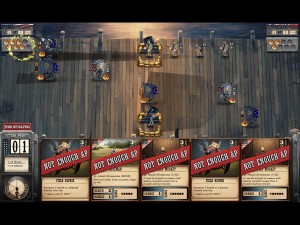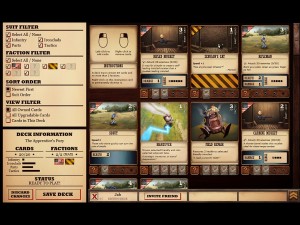Zachtronics Industries is becoming one of those studios where you’ll never know what’s coming next from them. Last time was the award winning Spacechem: Which used chemistry as a front for teaching the essence of programming. And now with Ironclad Tactics, it’s a CCG mixed with turned based strategy set to the backdrop of the Civil War… with robots.
The Nuts and Bolts of It:
The story of Ironclad Tactics is that at the eve of the civil war, an inventor by the name of Zebulon Wright creates the ironclads — automatons designed for all sorts of tasks. But when he disappears, the South strikes with an army of ironclads. It’s up to apprentice Maxwell Prosser to help the North win the war and find out what’s going on.
The first thing you’ll have to learn is how to build your deck. There are three kinds of cards in the game: Units that can be placed on the field, arms that can be attached to ironclads changing their utility and tactics that can affect units or the battlefield.
There are only two rules with building a deck; all decks must have 20 cards, no more or no less. And you can only have two factions of cards featured in a single deck. As you play through the campaign, you’ll unlock cards of different factions.
While each faction will have the same basic classes of cards, they feature wildly different utility and options for play. For example, the mercenary deck features ironclads that can push units back and an armament that can stop enemies from moving.
Moving to the actual gameplay, Ironclad Tactics is turned based, despite what screenshots may show otherwise.
Every turn lasts a few seconds and is split between both sides getting AP which is used for playing cards, units on the field performing an action and finally any available units will move forward unless you tell them to pause.
To win most maps, you need to get eight victory points before your opponent does. Victory points are earned by getting an ironclad across the field or capturing mortars on the map. Some ironclads will give different victory points which you can see on their card.
As we talked about on the cast, Ironclad Tactics features no micro transactions; instead cards are unlocked via play and completing challenges.
Many maps have optional side goals and playing multiplayer and winning can unlock more cards. The game is balanced though around being able to beat the story campaign with the basic cards unlocked, but the additional cards allow you to further flesh out your deck.
Zack talked about on the cast, the “feedback loop of awesome” in the game based around deck building and there is a certain elegance around it. Since you only have 20 cards per deck, it makes each card stand out more.
By keeping weapon damage values from 1-3, it prevents any of the cards from being deemed useless or replaceable. Add in the different factions and the deck building really comes alive.
The game also comes with both competitive multiplayer and every stage of the campaign can be played co-op with a friend.
However I couldn’t find any friends who bought the game and was unable to test this feature out.
But for all the streamlined design, Ironclad Tactics can’t escape some of the annoyances of CCG design.
A House Divided… :
Like any game built around CCG design, the difficulty curve of the game can be uneven in some places. Many story levels feature special twists that demand certain cards in your deck or to use specific tactics and this can cause the difficulty to be all over the place. Also the fact that you are dealing with a deck that is randomly shuffled also adds to the difficulty, when you are hoping and praying for that one card you need to show up in your hand.
One story level in particular with defensive walls caused me some frustration until I retailored my deck for it. Don’t let the screenshots fool you, Ironclad Tactics is not a game that you can just pick up and play.
One minor control issue that bugged me was that it can be tricky to get units that move multiple spaces to stop after only moving one spot. Since you have to click on the unit to issue the pause command, you have to try and catch them while they’re on the specified square and before they move off.
Like Spacechem before it, there is a lot of hidden depth under the surface this time with deck building. And truthfully, it’s one of those games that you really have to be in the mood to play. If you’re not interested in the complexities of deck building then you will not have a good time in Ironclad Tactics. The game leaves it up to you to explore deck building and figure out things on your own.

While the game is turned base, the time per turn is quick enough to keep the game moving at a fast pace.
I would have liked more cards from the various factions besides the starting one as the army deck comes with enough varying cards for you to build an entire deck around with several strategies.
But the other factions do seem to be better off as a synergistic relationship with another faction.
Ultimately the biggest issue with the game and what we sort of talked about on the cast is that the game right now lacks some of the amenities of other popular CCGs.
Because all the cards are set in the sense that everyone has access to the same pool and the chance to acquire them, it does in a way limit the lasting appeal of multiplayer. However this was intentional to balance the game as if they had rare cards with higher stats, it would just upset everything.
I would have liked to have seen more content, especially more challenges that would have made use of the other factions. I’m willing to bet that a lot of people will blow through the campaign (which only takes a few hours) with the army deck, play a few rounds of multiplayer and then file the game away for good, never touching the other factions.
Which is a shame as Ironclad Tactics is a really great foundation I think for a viable CCG platform. As I said on last week’s cast, all of a sudden it’s a good day to be a CCG fan. Between Card Hunter and Ironclad Tactics, we have two very strong showings for the genre and I hope that we continue to hear from both of them for a long time.




